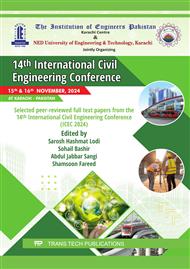p.3
p.11
p.19
p.27
p.43
p.51
p.61
p.73
Behavior of RC Beam-Column Joints Using High-Strength Concrete and Engineered Cementitious Composite
Abstract:
In seismically active areas, the structural integrity of structures is significantly reliant on the efficacy of beam-to-column connections. This study investigates the potential of high-strength concrete (HSC) and engineered cementitious composites (ECC) as alternatives to conventional transverse reinforcements to alleviate joint congestion and enhance the performance of beam-column joints. Four full-scale models were tested, including progressive and cyclic load evaluations. Two models had HSC, HBCJ I (HSC in joint only), and HBCJ II (HSC in joint plus extended to members), and the other had ECC joints EBCJ I (ECC in joint only) and EBCJ II (ECC in joint plus extended to members). The evaluation encompassed load-bearing capacity, ductility, strength, and overall effectiveness. ECC exhibited superior performance to HSC in terms of ductility and load-carrying capacity. Peak displacements significantly increased with ECC by 35% from HBCJ I to EBCJ I and 19.1% from HBCJ II to EBCJ II. Furthermore, peak load-carrying capacity increased by 6% and 16%, respectively. ECC demonstrated its ability to improve seismic performance and reduce congestion, an essential issue in structural engineering, by meeting shear stress needs in joints without transverse reinforcement.
Info:
Periodical:
Pages:
3-10
Citation:
Online since:
April 2025
Authors:
Price:
Сopyright:
© 2025 Trans Tech Publications Ltd. All Rights Reserved
Share:
Citation:


